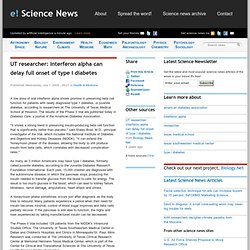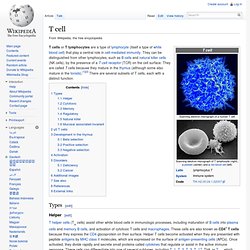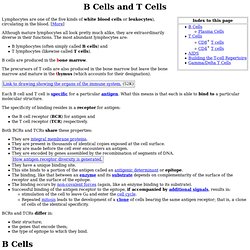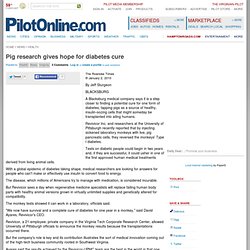

Libraries. Scholarly Articles. Antigens. White Blood Cells. PKCδ Blues for the β-Cell. UT Southwestern researchers studying new treatment for Type 1 diabetes. Researchers at UT Southwestern Medical Center at Dallas are studying a new treatment for Type 1 diabetes that they hope will be a major step forward in the management of the disease, which affects the daily lives and lifelong health of millions of people.

The study is funded by Juvenile Diabetes Research Foundation and Amylin Pharmaceuticals. UT Southwestern physicians leading the study said Tuesday that they have been able to control levels of blood glucose in animals using metreleptin, a synthetic version of the human hormone leptin. If the same result can be achieved in humans, it could have an enormous impact on how Type 1 diabetes is controlled, with the hope that it could reduce the number of daily insulin injections diabetics must now endure, researchers said during a news conference at Dallas City Hall. Type 1 diabetes is an autoimmune disorder that is usually diagnosed in children and young adults. Dr. Dr. UT researcher: Interferon alpha can delay full onset of type I diabetes. A low dose of oral interferon alpha shows promise in preserving beta cell function for patients with newly diagnosed type 1 diabetes, or juvenile diabetes, according to researchers at The University of Texas Medical School at Houston.

The results of the Phase II trial are published today in Diabetes Care, a journal of the American Diabetes Association. "It shows a strong trend in preserving insulin-producing beta cell function that is significantly better than placebo," said Staley Brod, M.D., principal investigator of the trial, which includes the National Institute of Diabetes and Digestive and Kidney Diseases (NIDDK). "It can extend the 'honeymoon phase' of the disease, allowing the body to still produce insulin from beta cells, which correlates with decreased complication rates.
" As many as 3 million Americans may have type I diabetes, formerly called juvenile diabetes, according to the Juvenile Diabetes Research Foundation International. Long Acting Insulin. UT Southwestern researchers on verge of possible diabetes breakthrough. Researchers at UT Southwestern Medical Center reported findings Wednesday that may suggest new ways to treat Type 1 diabetes, a disease that affects more than a million Americans.

The results, if confirmed, may show that insulin could one day not be the only successful treatment for the illness. In a paper to be published in February’s edition of the journal Diabetes, the researchers describe an experiment on specially bred mice that by all rights should have developed the debilitating symptoms of diabetes — but did not. Dr. Roger Unger, who has been researching diabetes at UT Southwestern for five decades, cautiously suggested the results may point in the direction of a better treatment than is now available.
But he was quick to point out that there are no immediate benefits for patients. “We can’t make any predictions about humans,” he said. It acts like a key to a gas cap, letting many kinds of cells absorb sugar from the blood to use for fuel. “I feel very strongly about that,” he said. T cell. T cells or T lymphocytes are a type of lymphocyte (itself a type of white blood cell) that play a central role in cell-mediated immunity.

They can be distinguished from other lymphocytes, such as B cells and natural killer cells (NK cells), by the presence of a T-cell receptor (TCR) on the cell surface. They are called T cells because they mature in the thymus (although some also mature in the tonsils).[1][2] There are several subsets of T cells, each with a distinct function. Types[edit] Helper[edit] B Cells and T Cells. Lymphocytes are one of the five kinds of white blood cells or leukocytes), circulating in the blood.

[More] Although mature lymphocytes all look pretty much alike, they are extraordinarily diverse in their functions. Pancreas. Structure[edit] 1.

Bile ducts: 2. Intrahepatic bile ducts, 3. Left and right hepatic ducts, 4. Common hepatic duct, 5. The pancreas is an endocrine organ that lies in the abdomen, specifically the upper left abdomen. Journal of Diabetology - Official Journal of Diabetes in Asia Study Group. Insulin not the only way to treat diabetes: Study. A new study may have found a way for people with type-1 diabetes to forgo time-consuming and costly insulin injections.

The study, out of the UT Southwestern Medical Center, suggests suppressing a single hormone might eliminate the need for insulin. Injecting the hormone insulin has long been the only way for people with type-1 diabetes to regulate their blood-sugar levels, but it's never been enough on its own to treat the disease. Pig research gives hope for diabetes cure. By Jeff Sturgeon A Blacksburg medical company says it is a step closer to finding a potential cure for one form of diabetes, tapping pigs as a source of healthy, insulin-oozing cells that might someday be transplanted into ailing humans.

Revivicor Inc. and researchers at the University of Pittsburgh recently reported that by injecting sickened laboratory monkeys with live, pig pancreatic cells, they reversed the monkeys' Type I diabetes. Tests on diabetic people could begin in two years and, if they are successful, it could usher in one of the first approved human medical treatments derived from living animal cells. With a global epidemic of diabetes taking shape, medical researchers are looking for answers for people who can't make or effectively use insulin to convert food to energy. The disease, which millions of Americans try to manage with medication, is considered incurable. The monkey tests showed it can work in a laboratory, officials said. Diabetes cases expected to double by 2030.